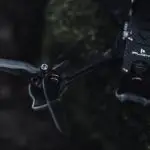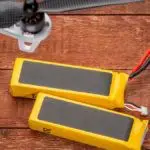Being a crucial and relatively dangerous component of your FPV drone, I cannot highlight more on the importance of proper caring for your LiPo battery pack. This is why I’ve made this care guide to show you the LiPo battery dos and don’ts.
FPV pilots consider LiPo batteries dangerous because these batteries are known to catch fire. There are various factors causing the LiPo to catch fire, and improper handling is one of them.
Following the tips below list will help you get the most out of your LiPo by prolonging their lifespan, as well as protect you from dangerous situations such as fires and explosions caused by improper handling.
On top of proper LiPo battery care, using high quality LiPo battery packs from reliable manufacturers and smart chargers can also greatly reduce the chance of damaging your LiPo, and extend its life. You should also protect the LiPo from the impact of crashing through various means.
Let’s go straight into the list.
- Always read the manufacturer’s instructions
- Charge your LiPo under supervision
- Do not overcharge LiPo batteries
- Charge your LiPo in a LiPo box
- Charge your LiPo at 1 C
- Always balance charge your LiPo
- Do not over discharge your batteries
- Storage charge your LiPo battery before storing them
- Charge just before you want to fly your FPV drone
- Do not keep the batteries connected to your drone
- Keep away from heat
- Don’t freeze your batteries
- Keep your LiPo batteries in fire-proof container
- Label your LiPo batteries
- Check your LiPo with battery checker
- Change a new LiPo battery if you need to
- Dispose your LiPo battery safely

Always read the manufacturer’s instructions
Your LiPo battery comes with manufacturer instructions on how to handle the battery and what are the safety precautions. Batteries from different manufacturers may have different care requirements and safety risk. Make sure you read and follow the instructions!
Charge your LiPo under supervision
The chemistry in a LiPo battery is very volatile when being charged. While the likelihood is not high, there is a possibility where the LiPo battery can catch fire when charging, especially if you are using a low quality or damaged LiPo.

You want to make sure that you are there when LiPo catches fire so that you can handle the situation. Consider having a fire extinguisher near to where you are charging. While it is not easy to put out a LiPo fire, you can at least contain it from spreading.
Never charge your LiPo when you are sleeping!
Do not overcharge LiPo batteries
Avoiding overcharging is perhaps the most important tip in LiPo battery care.
Deliberately overcharging your LiPo can give you an extra boost in a race, as it gives your drone extra power. However, overcharging is dangerous!
Your LiPo is designed to carry 4.2 V safely when fully charged. If you force charge your LiPo above its limit, it can damage your battery, or worse, cause a fire.
By using smart chargers that stop charging when the recommended voltage is reached, you can avoid the associated risks.
Charge your LiPo in a LiPo box
To manage the risk of fire, you should keep your LiPo battery in a closed fire-proof box (buy from Amazon | GetFPV | Banggood). In case the LiPo catches fire, the fire-proof box can contain the fire while you handle the situation. If you are using smaller batteries such as 4S, you can put them in a LiPo bag (buy from Amazon | GetFPV | Banggood) instead.
You can also use an ammo box instead, after removing the seal.
Here’s a video experimenting with different fire containment methods when charging LiPo batteries.
Charge your LiPo at 1 C
Many chargers allow you to charge your LiPo battery at 2 C or 3 C charge rate. This is very appealing because everyone wants to spend more time flying instead of charging LiPo.
Technically, all LiPo batteries can be charged at a higher rate. However, doing so will reduce the life of your battery, and potentially burn houses down.
It is generally safer to charge your LiPo at a lower charging rate, which also prolongs your battery’s life. Most manufacturers recommend charging their LiPo at 1 C.
Having said that, with the advancement of new technology, more advanced LiPo batteries can be charged at a higher charge rate. You can charge at more than 1 C charge rate only if the battery specification says so.
Always balance charge your LiPo
There are 2 common charging modes that you can use to charge your LiPo batteries: direct/fast charging and balance charging.
In direct/fast charging mode, the charger charges the battery pack as a whole. Often, not all cells would be charged to the same voltage. Some could be overcharged, which some could be undercharged.
As mentioned earlier, overcharging your LiPo may risk degradation of battery life, battery swelling, and even fire. On the other hand, under charging affects the performance of your drone.
This issue can be resolved by balance charging. In balance charging, the charger charges each cell individually so that each of them are fully charged at 4.2 V. This is slightly slower than direct/fast charging.
The extra charging time is insignificant compare to the improved battery life and safety. Hence, always do balance charging.

Do not over discharge your batteries
As your FPV drone flies, the voltage in your battery is being discharged. Discharging the LiPo battery lower than 3.3 V per cell will permanently damage the battery. If you are using a 4S battery, the lowest tolerable voltage is 13.2 V (3.3 V x 4). But you don’t want to go till 3.3 V. Instead, stop at 3.5-3.6 V per cell so that you have some buffer to play with.
There are a few ways to gauge the voltage of your battery mid-flight. Certain drone components such as the FPV camera and flight controller may come with built-in voltage sensors that feed you the voltage reading on your FPV screen or your radio transmitter’s telemetry screen.
Otherwise, you can install a buzzer (buy from GetFPV | Amazon | Banggood) on your LiPo to give you warning when the voltage is too low.
When the LiPo battery voltage drops below 3.5-3.6 V, you should call back your drone and change the battery.
Modern ESC has a low voltage cut off functionality. It either does a hard cutoff where the drone is immediately shut off if the voltage dropped below a preset level, or a soft cutoff where the output power is gradually reduced. You should set it at a higher such that the cut off kicks in before 3.3 V. This will serve as a failsafe feature to prevent over discharging your LiPo batteries.
Note that some LiPo batteries have a lower recommended minimum voltage at 3 V, or even lower. But I will stick to 3.5 V for the ease of calculation and consistency when managing different batteries.

Storage charge your LiPo battery before storing them
Most of us don’t fly every day. Sometimes we fly weekly, and sometimes we might stop flying for a few weeks or months due to various reasons.
To keep your LiPo batteries at their top shape even if you need to store them for years, you must not store them fully charged or fully discharged. Either one of those will damage your battery. Instead, it is best to storage charge your LiPo.
Storage charging basically discharges your LiPo battery to the desired voltage if the voltage is too high, or charges the battery to the desired voltage if the voltage is too low. This will prolong the lifespan of your LiPo even when you are not using it. If you need to store the LiPo for half a year or more, check the voltage every quarter and store-charge it if the voltage dropped.
Different chargers may storage charge your LiPo to different preset voltages. The most common storage voltages are somewhere between 3.7 V and 3.85 V. You can check with the battery manufacturers for the recommended storage voltage and follow their guidelines.
Charge just before you want to fly your FPV drone
Many of us will charge our gadgets so that we can use them whenever we want to. That’s a convenient but wrong practice. To prevent battery damage and fire, you should charge your LiPo batteries only when you need to use them.
Say, if you are flying on Saturday, you should charge your LiPo on Friday night or even better, on the Saturday itself. But what if it rains on Saturday and you need to postpone to Sunday? Well, it doesn’t make sense to discharge the batteries unless you are postponing the flight to a week later.
Do not keep the batteries connected to your drone
After every flight, you should remove the battery from your FPV drone. If you keep it in your drone, the battery will be further drained, and may reach a point that can cause damage.
Keep away from heat
Heat is a major factor that can degrade your LiPo battery. Never leave your LiPo in your car. Heat built-up in your car would damage your LiPo, and potentially cause fire.
You should keep your battery somewhere cool, at room temperature. Do not use the battery immediately after charging if it is still hot. Conversely, don’t charge your battery immediately after a flight when it is still hot.
Don’t freeze your batteries
A lot of “tips and hacks” on the Internet tell you to freeze your batteries to prolong their life. However, it can actually do more harm than good. That condensation inside your battery after you remove it from the freezer will damage your batteries. Plus, prolonged exposure to freezing can reduce battery life.
Do check out my blog if you want to get the best out of your LiPo when flying FPV in the cold winter.
Keep your LiPo batteries in fire-proof container
As mentioned, LiPo batteries are prone to fire. While fire incidents are rare, it is better to be safe than sorry. Always keep your LiPo, whether it is store-charged or fully-charged, in a fire-proof container. You can use an ammo box for larger batteries or lipo bag for smaller batteries.
Label your LiPo batteries
Almost all FPV pilots have more than 1 LiPo battery pack. Try your best to organize your batteries, especially when storing them! You would want to label them so that you don’t mix the old batteries with the new ones.
Check your LiPo with battery checker
A battery checker is a nice-to-have tool that allows you to check the condition and health of your LiPo batteries. It shows you the capacity of your battery, the remaining juice, overall and individual cell voltage, maximum charging and discharging rate, temperature, etc.

I recommend getting ISDT BattGo BG-8S to check your LiPo at a regular interval. By doing so, you can detect faulty LiPo batteries earlier before accident happens.
On top of battery checking, ISDT BattGo BG-8S can be used to balance the voltage of your LiPo packs, and used to check the signal strength of your radio.
Change a new LiPo battery if you need to
Sometimes, your LiPo battery may swell or puff due to mishandling or low battery quality. While there are guides claiming ways to fix it, I would advise against that. It is better to dispose of swollen or puffed batteries for safety reasons.
You should also change your battery if it shows significant performance degradation. The capacity of a battery degrades with each charging cycle. The degradation accumulates and becomes significant after a few hundred charging cycles. As a result, you will experience shorter flight time and lower drone speed, which indicate the need to change your battery for a new one.
Dispose your LiPo battery safely

Prior to disposing, you should fully discharge your LiPo battery. Some chargers are capable of doing this, but many can only discharge your battery down to 3 V.
The most reliable way to discharge your battery is to connect it to a circuit with lightbulbs and let the bulb drain your battery slowly. There are commercially available battery dischargers that help you do that.
There are videos showing people destroying old batteries by force using gunshot, hammer, nails etc. While those methods are fast, they are dangerous. I would recommend against that.
After discharging your LiPo, dispose of it at your local battery recycle center. In most places, LiPo batteries cannot be disposed of as a general waste.


